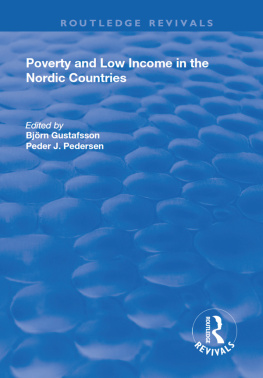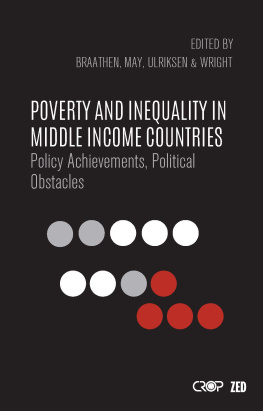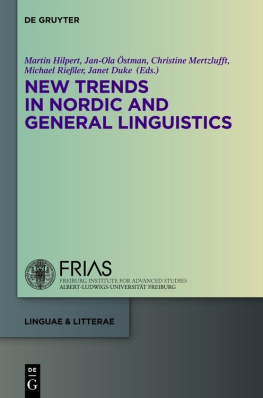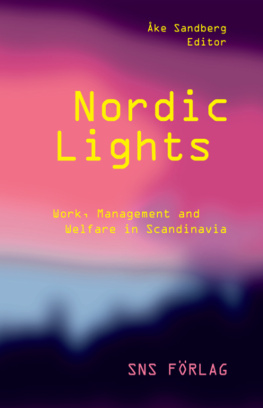POVERTY AND LOW INCOME IN THE NORDIC COUNTRIES
Poverty and Low Income in the
Nordic Countries
Edited by
BJRN GUSTAFSSON
University of Gteborg, Sweden
PEDER J. PEDERSEN
University of Aarhus and Centre for Labour Market and Social Research,
Denmark
First published 2000 by Ashgate Publishing
Reissued 2018 by Routledge
2 Park Square, Milton Park, Abingdon, Oxon OX14 4RN
711 Third Avenue, New York, NY 10017, USA
Routledge is an imprint of the Taylor & Francis Group, an informa business
Copyright Bjrn Gustafsson and Peder J. Pedersen, selection of editorial matter; individual chapters, the contributors 2000
All rights reserved. No part of this book may be reprinted or reproduced or utilised in any form or by any electronic, mechanical, or other means, now known or hereafter invented, including photocopying and recording, or in any information storage or retrieval system, without permission in writing from the publishers.
Notice:
Product or corporate names may be trademarks or registered trademarks, and are used only for identification and explanation without intent to infringe.
Publishers Note
The publisher has gone to great lengths to ensure the quality of this reprint but points out that some imperfections in the original copies may be apparent.
Disclaimer
The publisher has made every effort to trace copyright holders and welcomes correspondence from those they have been unable to contact.
A Library of Congress record exists under LC control number: 99073697
ISBN 13: 978-1-138-70301-8 (hbk)
ISBN 13: 978-1-315-20341-6 (ebk)
Contents
BJRN GUSTAFSSON AND PEDER J. PEDERSEN
PEDER J. PEDERSEN AND NINA SMITH
MARKUS JNTTI AND VELI-MATTIRITAKALLIO
STEFN LAFSSON AND KARL SIGURSSON
ROLFE AABERGE, ARNE S. ANDERSEN AND TOM WENNEMO
BJRN GUSTAFSSON
BJRN GUSTAFSSON AND PEDER J. PEDERSEN
The initiative for this book stems from a dialogue between the Nordic Council and the Nordic Council of Ministers. This lead to a research project in which social scientists from Denmark, Finland, Iceland, Norway and Sweden co-operated in order to address a number of questions: How has the number of people living below a predetermined poverty line changed over time in the Nordic countries? Who are the poor in the various Nordic countries? How does poverty or low income at the individual level appear when the observation period is extended to cover a longer period of years?
There are at least two fundamental reasons why results from research on poverty in the Nordic countries could be of considerable interest for readers outside these countries as well. Firstly, the Nordic countries are well known for their ambitious social policies. Therefore, knowledge about poverty in the Nordic countries helps to suggest what would lie in store for other countries if their social policy ambitions increased. Secondly, in contrast to the situation in many other countries, data on household income have been collected using consistent methods in the Nordic countries over decades, making it possible to conduct analyses covering long periods of time. Data available in Denmark, Norway and Sweden make it possible also to investigate the dynamic aspects of poverty at the household level.
Questions on poverty and low income have, of course, previously been addressed on the basis of the experience from individual Nordic countries. The new aspect of this book is that it co-ordinates the statistical analyses. This has allowed the application of a more comparative framework than is usually possible in studies covering many countries and years. The results make it possible to compare the development of the extent of poverty and the poverty profile across the various Nordic countries. A comparative approach to poverty in the Nordic countries is particularly interesting as they have experienced rather different profiles of unemployment during recent decades.
The project was funded by the Nordic Council of Ministers as well as the Swedish National Board of Health and Welfare, where Annika Puide co-ordinated it. In an earlier report, Puide, A. (Editor) Den nordiska fattig-domens utveckling och struktur, Kbenhavn, Nordiska Ministerrdet (TemaNord 1996:583) results were reported using Danish, Swedish, English and Norwegian in the different chapters. The report was presented at a seminar in Stockholm in autumn 1996. We would like to thank Claes rtendahl, Else yen and Hans Hansen for giving us valuable comments on that occasion. The seminar also inspired us to continue the work and make the findings accessible to people not proficient in the Nordic languages.
In the continuation of the project we have taken several approaches. Firstly, authors of the various country chapters have updated the empirical descriptions by using newer data. This makes it possible to bring the analysis and description forward up to the middle of the 1990s. Secondly, all country chapters have been revised by their respective authors. Thirdly, we have rewritten and extended the introductory chapter, as well as adding a concluding chapter. Thus, while the book clearly builds on its predecessor, it also differs from it in many respects.
| Bjrn Gustafsson | Peder J. Pedersen |
| Gteborg, Sweden | Aarhus, Denmark |
BJRN GUSTAFSSON AND PEDER J. PEDERSEN
Poverty is a long-standing social issue in Denmark, Finland, Norway, Iceland and Sweden. For centuries, large parts of the population in the Nordic countries had to struggle hard for survival as, until the last hundred years, the general standard of living was low in these predominantly agrarian economies. The public provision of income support was only rudimentary and consisted of stringently means-tested poor relief to the destitute who could not work.
However, industrialisation, in the second half of the last century, brought widespread change and rapid economic growth. At the turn of the century, GNP per capita in the Nordic countries was significantly lower that the average among the OECD countries. During this century, GNP per capita rose more rapidly in the Nordic countries than the average for the OECD area (cf. Maddison 1991, pp. 67). One of the results of this rapid growth was a reduction of poverty in the absolute sense of the word.
During this century, other forces reduced the importance of the issue of poverty in the Nordic countries. Unemployment was very high in the Nordic countries in the inter-war years, but became a much smaller social and political problem after World War II. Unemployment remained low in the Nordic countries, except Denmark, until around 1990, in contrast to most other Western European countries, which experienced a growing problem of unemployment from the mid-1970s.
Ever more ambitious social security programmes materialised during the long period of full employment. The public sector grew rapidly, especially during the 1960s and 1970s. As a consequence of these changes, poverty moved down on the agenda of social policy in the Nordic countries. The discontinuity with the past was also marked by the renaming of programmes for poor relief
Not only from a historical perspective but also from an outsiders point of view, poverty in the absolute sense of the word in the contemporary Nordic countries can be considered as a not very serious subject. When the World Bank counts the poor in the world in its World Development Report their figures do not include inhabitants of the Nordic countries. However, when the frame of reference is narrowed from a global perspective to that of the industrialised countries, poverty or low income also exists in the Nordic countries.









